The 17th Lok Sabha (2019- 24): trends
This is a collection of articles archived for the excellence of their content. |
The 2019 elections: electioneering and the verdict
Seats lost or gained in 2019 vis-a-vis 2014
Briefly

From: May 24, 2019: The Times of India
17TH LOK SABHA
See graphic:
Seats and vote shares lost or gained by the main political parties in 2019 vis-a-vis 2014
Constituency-wise (map)

From: May 24, 2019: The Times of India
See graphic:
Constituency-wise maps of India showing the seats won by the main political parties in 2019 and 2014
Some statistics
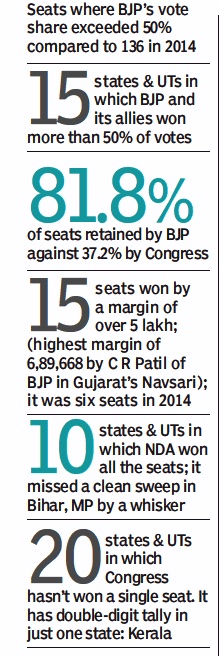
From: May 24, 2019: The Times of India
See graphic:
The 2019 LS elections: Some statistics
Victory margins in 2019
May 25, 2019: The Times of India

From: May 25, 2019: The Times of India
Margins tell story of BJP dominance
In four of the states where BJP managed a clean sweep — Gujarat, Delhi, Uttarakhand and Himachal Pradesh — such was its dominance that even the lowest margin was in lakhs. In the case of Gujarat it was close to 1.3 lakh, in Delhi and Uttarakhand 2.3 lakh and in Himachal 3.3 lakh.
The highest average margin for any party was, however, the DMK’s at almost 2.8 lakh, again illustrating the extent of the Dravidian party’s edge over its opposition in Tamil Nadu.
Not surprisingly, the next three parties on the list are all constituents of NDA — BJP, LJP and JD(U).
Among the states, the top five slots in terms of average margins were all occupied by states that BJP made a clean sweep of — Himachal, Delhi, Haryana, Rajasthan and Gujarat, in that order.
It’s no surprise, therefore, that the five biggest margins in these elections all were for BJP winners from these states. Four of them recorded margins of over 6 lakh and the fifth just narrowly missed that mark (see graphic). The biggest margin was in Navsari where C R Patil won by 6,89,668 votes.
At the other end of the spectrum, the list of the five smallest margins was a mixed bag, with two BJP winners and one each from the Congress, NCP and Trinamool. The narrowest margin of 181 was in Machhlishahr in UP, where Bholanath of the BJP beat his BSP rival Tribhuvan Ram.
Victory margins, state-wise, 2019

From: May 25, 2019: The Times of India
See graphic:
Victory margins, state-wise, 2019
Deposits: 86% of candidates forfeited them
Bharti Jain , Oct 12, 2019: The Times of India
Nearly 86% of the 8,026 candidates in the recent Lok Sabha poll forfeited their deposits, according to the statistical report for general election 2019 released by the Election Commission on Friday. The overall polling percentage in the last parliamentary election, including postal ballots, was 67.4%, which is the highest ever turnout in a Lok Sabha poll.
As per the statistical report — which covered 542 parliamentary seats, excluding Vellore where the poll was cancelled — just 587 of the 7,484 defeated candidates held on to their security deposit. BSP lost its election deposit in 345 of the 383 Lok Sabha seats its contested, Congress in 148 of the 421 contested, CPM in 51 of the 69 contested, CPI in 41 of the 49 contested, NCP in 14 of the 34 contested and Trinamool Congress in 20 of the 62 seats contested. BJP, which emerged the winner with 303 seats, lost deposits in 51 seats.
On the final vote share of national parties, the report said BJP polled 37.76% of valid votes, Congress 19.7%, Trinamool 4.11%, BSP 3.67%, CPM 1.77%, NCP1.4% and CPI 0.59%. The national turnout among women electors was marginally higher at 67.18% as compared to male electors (67%). The turnout of women voters surpassed the male turnout figures in 17 states/Union Territories, including Bihar, Uttar Pradesh and Jharkhand.
As per the state-wise turnout figures, Lakshadweep recorded the highest turnout at 85.21% across all states and UTs, followed by Nagaland (83%), even though West Bengal was the first among the bigger states with a poll percentage of 81.76%. Jammu and Kashmir recorded the lowest turnout at 44.97% while Bihar and UP clocked 57.35% and 59.21% turnout respectively.
Dhubri in Assam emerged as the constituency with the highest turnout of 90.66% while Anantnag in J&K, where polling was spread over three phases due to security concerns, recorded the lowest turnout of 8.98%. Postal ballots received in the 2019 parliamentary poll totalled around 28 lakh, though only around 22.8 lakh were found to be valid with over 5 lakh rejected.
Percentage of votes obtained by winning candidates
Caste and the 16th Lok Sabha
Minority pockets
BJP fares well in minority pockets
May 29, 2019: The Times of India
BJP fares well in 'minority-concentration' districts, wins over 50% seats
NEW DELHI: The BJP has managed to puncture opposition's claims that the party is anti-minority by winning more than 50% of the Lok Sabha seats in 90 'minority-concentration' districts identified in 2008 by the then UPA government.
Besides a considerable minority population, these districts have both socio-economic and basic amenities indicators below the national average. Of the 79 such constituencies, the BJP has won the maximum of 41 seats, a gain of seven over 2014. The Congress's share has almost halved, down from 12 in 2014 to six now.
An analyst claimed that Muslims did not vote en bloc in favour of one party or candidate this time.
On the other hand, 27 Muslim candidates won in the recently-concluded elections. However, none of the six Muslim candidates fielded by the BJP tasted success.
The winning MPs are from Trinamool Congress (5); Congress (4); Samajwadi Party, Bahujan Samaj Party (BSP), National Conference and Indian Union Muslim League (IUML) (3 each); AIMIM (2); LJP, NCP, CPI(M) and AIUDF (one each).
The Opposition parties have been accusing the BJP of not doing enough for the minorities and also aiding and abetting attacks on them.
Nearly 20% of the country's 130 crore people are Muslims.
In the minority-concentration districts, the BJP gained the most in West Bengal, which has 18 such seats. In Raiganj in Uttar Dinajpur district which has a Muslim population of nearly 49%, BJP's Debasree Chaudhuri defeated TMC's Agarwal Kanaialal by 60574 votes.
In neighbouring Jalpaiguri seat, BJP candidate Jayanta Kumar Roy defeated sitting TMC MP Bijoy Chandra Barman by 184004 votes. The seat has about 20% Muslim population.
In Maldaha North seat in Malda, the party's Khagen Murmu won defeating TMC's Mausam Noor by a margin of 84288 votes. The seat has nearly 50% Muslim population.
In Coochbehar seat which has a Muslim population of around 30%, BJP's Nisith Pramanik got the better of his nearest rival TMC's Paresh Chandra Adhikary by 54231 votes.
In Balurghat in North Dinajpur district, BJP candidate Sukanta Majumdar defeated TMC's Arpita Ghosh by a margin of 33293 votes. The seat has 35 percent Muslim population.
In Bishnupur Lok Sabha seat (20%) in Bankura, BJP candidate Saumitra Khan won by 78047 votes defeating his Trinamool Congress rival Shyamal Santra.
In Hooghly seat (20%), Locket Chatterjee of the BJP defeated his TMC rival Ratna Dey (Nag) by a margin of 73362 votes while S S Ahluwalia of BJP won the Burdwan-Durgapur seat by a slender margin of 2439 votes defeating his nearest AITC rival Mamtaz Sanghamita. The seat has around 15% Muslim population.
The UPA government in 2008 had identified the 90 minority-concentration districts under a development programme that focussed on education, health and skill development in these districts.
Rampur, Nagina, Moradabad, Sambhal and Amroha are among the 20 Lok Sabha seats in Uttar Pradesh where Muslim voters are in a very large number.
Though the BJP performed well in the state, ensuring that the SP-BSP-RLD combine does not get a cake walk, the 'mahagathbandhan' bagged these five seats.
In Rampur, where Muslims account for nearly 50% of the voters, veteran SP leader Azam Khan defeated BJP candidate and actor-turned-politician Jaya Prada by over one lakh votes.
The BSP won the Nagina seat when its candidate Girish Chandra defeated sitting BJP MP Yashwant Singh by over 1.66 lakh votes.
In Moradabad, ST Hasan of the SP defeated sitting BJP MP Kunwar Sarvesh Kumar by nearly 99,000 votes.
Another SP candidate, SR Barq defeated Parmeshwar Lal Saini of BJP in Sambhal seat.
In Amroha, Kunwar Danish Ali, who had defected from the Janata Dal (Secular) and had joined the BSP just ahead of the polls, emerged victorious trouncing sitting BJP MP Kunwar Singh Tanwar.
The Congress had fielded six Muslim candidates in Uttar Pradesh, but none of them won.
In the entire state, Muslims account for nearly 20% of the population.
In the 2014 Lok Sabha polls, not a single Muslim candidate won and the jinx was broken only during Kairana bypoll when the seat was wrested from the BJP by Tabassum Hassan, the joint opposition candidate, who had contested on RLD ticket. In Bihar, there are seven such seats, and in Kishanganj, which has around 65% Muslim population, Congress's Mohd Javed defeated JD(U)'s Syed Mahmood Ashraf by 34,466 votes.
In Araria (45%), BJP's Pradip Kumar Singh defeated sitting RJD MP Sarfaraz Alam by 1,37,241 votes while in Katihar (40%) Congress's Tariq Anwar (sitting MP, who won the seat on an NCP ticket) lost to Dulal Chandra Goswami of the JD(U) by 57,203 votes.
Darbhanga, having a Muslim population of about 23%, saw BJP's Gopal Jee Thakur defeating RJD's Abdul Bari Siddiqui by 2,67,979 votes.
In Khagaria (23%), sitting Lok Janshakti Party MP Mehboob Ali Kaisar defeated Mukesh Sahni of VIP by 2,48,570 votes, while in Banka (20%) JD(U)'s Giridhari Yadav prevailed over sitting RJD MP Jai Prakash Narain Yadav by 2,00,532 votes and in Madhubani (19%), BJP's Ashok Yadav defeated VIP's Badri Purbe by 4,54,940 votes.
In Assam, the Congress won two of the seats where there is a sizeable Muslim population — Abdul Khaleque in Barpeta (over 45%) and Pradyut Bordoloi in Nowgong (over 34%). AIUDF chief Badruddin Ajmal emerged winner in Dhubri, where the Muslim population is over 65%.
Muslims
Women
Expenditure of political parties
Mismatch been candidates’ and parties’ figures
Postal ballots
May 27, 2019: The Times of India

From: May 27, 2019: The Times of India
NDA got lower share of postal votes in Guj, TN than its overall vote share
With the armed forces and their martyrdom being made a central issue in the polls, you might expect that the votes of the services and central paramilitary forces would go overwhelmingly towards the NDA. An analysis of postal votes, a good indicator of the preferences of this section, however, shows that while the men and women in uniform in most states did support the NDA more than the general population, there were exceptions like the PM’s home state Gujarat and Tamil Nadu. In these states, the NDA actually got a significantly lower share in postal votes than its overall vote share.
Postal ballots are allowed for the armed forces, government officers on duty outside their state and for paramilitary forces including CRPF, BSF and ITBP. Of a total of over 22 lakh postal votes, the highest number came from the most populous state, UP (2.6 lakh), followed by Andhra Pradesh (2.3 lakh) and Maharashtra (2.2 lakh).
Among states which had over one lakh postal votes, West Bengal showed the highest skew in support for NDA with over 60% of these postal votes going to the BJP compared to just 40.3% of the overall votes. In Uttar Pradesh too, the NDA got almost 60% of the postal votes compared to just under 50% overall. Similarly, in Rajasthan nearly 68% of postal votes were for NDA compared to 61% overall.
However, in Tamil Nadu, the NDA’s share of 20% in postal votes was much lower than the 30.3% it got overall. Similarly, in Gujarat, the BJP won 58.6% of postal votes against 62.2% overall. In states with strong regional parties, the postal votes exhibited a similar pattern to the overall voting. For instance, the YSRCP and TDP between them got nearly 90% of postal votes in Andhra Pradesh, with Jagan Reddy’s party getting over 54% and TDP just under 36%.
Interestingly, Kanhaiya Kumar, the CPI candidate from Begusarai, who had been painted by the BJP as a leader of the ‘tukde tukde gang’, got 2,059 postal votes or about 25% of those cast for that seat. This was slightly higher than his overall vote share of 22%.
SC/ST constituencies
The intensification of the Modi wave during the elections
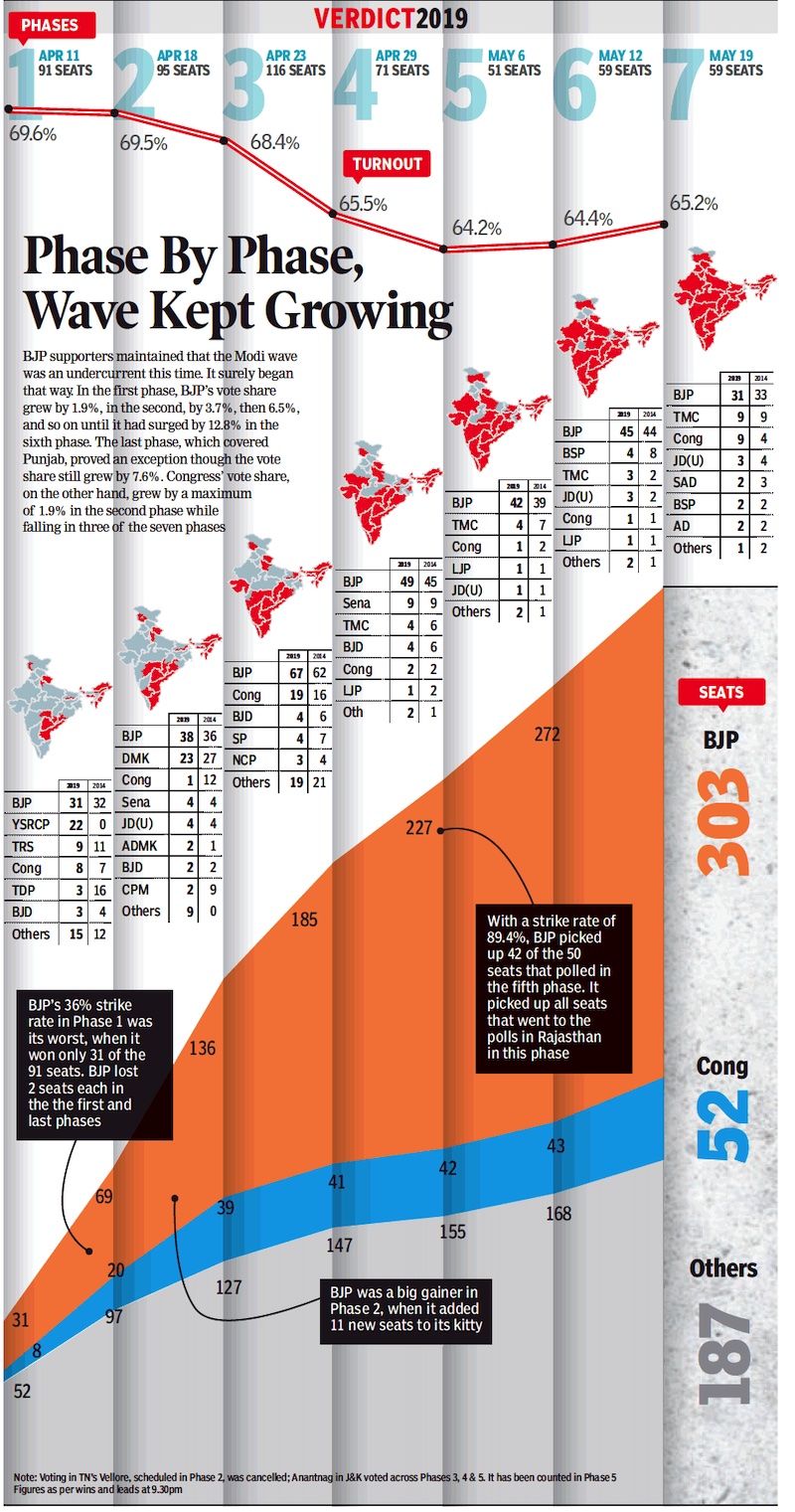
From: May 24, 2019: The Times of India
See graphic :
The intensification of the Modi wave during the elections
Big names in the fray
The winners
May 24, 2019: The Times of India
WINNERS
Narendra Modi and Amit Shah were the decisive winners of 2014. On Thursday, they emerged even more dominant. Here are the other notables
JAGANMOHAN REDDY It’s a dream comeback for a leader who found himself without a party and friends after father YSR died. He is now the dominant player in Andhra Pradesh. Sometimes seen as impulsive, Jagan kept going for five long years in the opposition even as TDP poached his MPs. In the end, the cub came of age, and a new tiger of Kadapa roared
M K STALIN After a long wait as heir apparent, Stalin can now legitimately claim to have filled his father Karunanidhi’s big shoes. But the DMK-led sweep will not unseat the AIADMK and Stalin will have to wait to claim the CM post. A new chapter in his career will begin as sole arbiter of DMK fortunes. He will be helped by the splintering of the AIADMK, but will need to develop equations with other regional leaders
NAVEEN PATNAIK The challenge posed by BJP can be gauged by pictures BJD released of the Odisha CM in a gym. Not one to be moved to sudden exertion, Naveen babu hung in to retain the assembly, extending his unbroken record since 2000. BJP mounted a stiff challenge in the Lok Sabha polls and its vote soared as it filled the vacuum created by Congress’s collapse
NITISH KUMAR The JD(U) leader made a smart move when he risked the ire of “secular” commentators and returned to NDA. The alliance’s sweep of Bihar justifies his decision. BJP numbers, however, mean he can play only a limited role at the Centre. The provocative comments by JD(U) leaders — seen as a deliberate move to keep BJP off balance — will now lack bite and the alliance will putter along
The losers
May 24, 2019: The Times of India
LOSERS
Rahul Gandhi is undoubtedly the biggest loser. Here are some others
MAMATA BANERJEE Her shrill attacks on PM Modi were intended to position her as a challenger who could halt the saffron juggernaut. In her bid to consolidate Muslim votes — and shut out the Left and Congress — she triggered a counterpolarisation that shook her hold on West Bengal. After ruling Bengal since 2011, Didi faces a real threat in Force Modi for the assembly elections in 2021
N CHANDRABABU NAIDU A leader once seen as a true reformer, he switched sides and doubled back so often that even loyal supporters now find him hard to read. Spooked by the rise of YSR Congress, and unable to get his way with Modi, Babu left NDA in a huff. BJP lost its toehold in AP but Naidu has lost his home turf and his dream of a role in national politics lies in tatters
AKHILESH YADAV SP insiders say his feuding with family seniors has cost him. Uncle Shivpal used to manage booths and the party machinery; the Yadav heir does not have a taste for grassroots. While the organisation suffered, its Yadav base was not fully at ease with BSP. The losses are worrying as an SP-BSP alliance was seen as the surest antidote to BJP. SP could be staring at a long exile
LALU PRASAD AND TEJASHWI Hampered by Lalu being in jail, RJD flopped at the hustings. Not only did it face a formidable foe in the JD(U)-BJP-LJP combine, Tejashwi was clearly seen as green behind the ears. Brother Tej Pratap’s antics didn’t help either. The party that called the shots in Bihar and Delhi finds itself reduced to the margins. Prospects of a swift revival seem dim, for now
ARVIND KEJRIWAL AAP now has just one LS seat, from Punjab. The Delhi CM’s maverick actions seem to have hurt the party in its base too, with AAP’s vote share slipping behind Congress. The bizarre negotiations with Congress seem to have damaged AAP’s chances as voters opted for BJP. He will now face a stern test in keeping his flock together ahead of the 2020 state election
SITARAM YECHURY The Left finds itself in dire straits, drawing a blank in its traditional bastions of Bengal and Tripura, scoring a lone win in Kerala, and piggybacking on DMK in TN. There was a time when the Left was intrinsic to any opposition mobilisation, but an ill-considered quest for pacts and being on the wrong side of the faith divide over Sabarimala cost it dearly
The Congress’ big losers
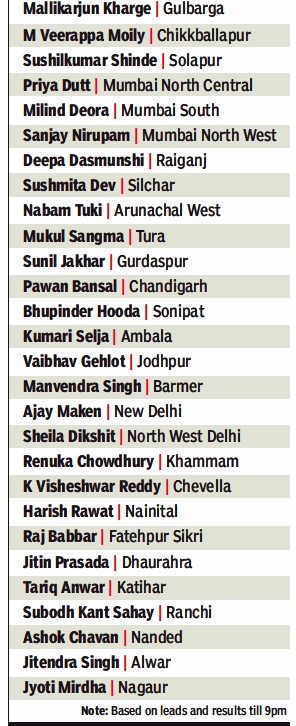
From: May 24, 2019: The Times of India
See graphic:
Congress' Big losers, May 2019
The regional parties’ big losers
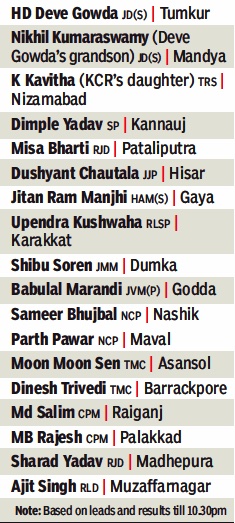
From: May 24, 2019: The Times of India
See graphic:
The regional parties’ big losers
Two survivors
May 24, 2019: The Times of India
MAYAWATI The result is better than BSP's zero seats in 2014, and she won more seats than SP, thanks to her base of Jatav voters. But the Dalit party continues to face rough weather. Its numbers are a steep fall from when behenji and mentor Kanshi Ram re-wrote caste politics of UP and much of north India by empowering Dalits
K CHANDRASEKHAR RAO After a golden run which saw him winning two straight elections, he has stumbled. He unexpectedly ceded some seats to BJP and Congress, with his daughter too losing. His dream of playing a national role – it was said he saw himself as deputy PM – has been dashed and he'll have to be content with being boss of Telangana
Three high-profile contests
May 24, 2019: The Times of India
3 Headline Fights, 1 Result
A right-wing hawk versus a youth communist icon, a veteran politician versus a Hindutva hardliner, a Union minister versus a rebel crossover candidate – these elections have thrown up the unlikeliest of contests. Polarisation was the name of the game even as debutants Kanhaiya and Pragya bent traditional campaign and vote bank narratives
Reluctant candidate steamrolls Left newbie
This north Bihar seat came under the spotlight as former JNU students’ union president Kanhaiya — seen as the underdog facing R S S-BJP veteran and Union minister Giriraj Singh — whipped up a crowdfunded campaign featuring Bollywood personalities and 300-odd volunteers, including JNU alumni. Despite Singh’s initial fears of contesting from an away-home seat (his turf being Nawada), he appears to have got the backing of a majority of the 5 lakh Bhumihar voters though the Muslim vote went to Kanhaiya and RJD’s Tanveer Hassan, who finished third.
Pragya pulls off big win against Digvijaya
Digvijaya’s nomination from Bhopal was met with silence from BJP for weeks together before Sadhvi Pragya, an accused in the Malegaon blasts, was named as a challenger. BJP has not lost the seat since 1989 and the record stands despite Pragya’s polarising rhetoric in the run-up to the polls. She made the contest about Hindutva, even targeting late ATS chief Hemant Karkare, and spoke in favour of Nathuram Godse. While Pragya painted herself as a victim of biased investigations into “saffron terror”, Digvijaya failed to stitch together a counter-narrative.
LS debutant Prasad ousts turncoat Shotgun
Shatrughan Sinha had won this seat twice on the trot, but that was when he was in BJP. This time, the change in political affiliation was accompanied by a change in fortunes as the Bihari Babu lost to erstwhile party mate Ravi Shankar Prasad, who incidentally was making his Lok Sabha poll debut. Notwithstanding the filmi pull Sinha brought to the contest, the fact that the seat is seen as a BJP bastion seems to be what mattered in the end. That would explain why, despite winning the seat by a 2.6 lakh-vote margin in 2014, Sinha ended second best against the Union law minister.
Vignettes: Nine firsts
May 24, 2019: The Times of India
firsts 9 in this poll
Longest In Recent Times
This election has been the longest in recent decades — 38 days. The four-day election of 1980 was the shortest. The EC came in for flak for its schedule, which the opposition alleged favoured the ruling BJP at the Centre. Troop movement and logistics usually define the planning of the mammoth exercise
Most Expensive At 70k cr
A verrrry rich first. Experts believe the spend on this election could have been at least $8.5 billion, and as much as $10 billion (Rs 70k cr), a first in that it was much more than the $6.5 billion spent in the 2016 US general election.With 542 MPs to be elected, average campaign expenditure per LS seat was tipped at a staggering Rs 129 crore! We doubt all of this will show up in official EC data
Ambani Blessings
The friendship between India’s richest man Mukesh Ambani and Congress nominee Milind Deora’s father, the late Murli Deora, is legendary. But in a first, the industrialist, along with banker-businessman Uday Kotak, released a video message endorsing Deora’s candidature in Mumbai South
All Campaign, No Contest
This time a number of high-profile politicians with their own outfits grabbed eyeballs and livened up the election — though not all of them contested. Leading the pack was MNS’s Raj Thackeray, who did sharper takedowns of the BJP-Sena than the Cong-NCP could. His surgical video strikes against BJP went viral. Another headline-grabbing canvasser was Kamal Haasan whose “First extremist in independent India was a Hindu” comment in TN after elections in the state, but before the last crucial phase, stirred up a hornet’s nest, and confused the EC. An emotional Yogendra Yadav and superstar Rajinikanth also weighed in
Third Gender In Fray
There were at least four candidates who identified themselves as third gender and contested from seats in Maharashtra, Gujarat and UP. Among them was a Hindu monk fielded by AAP in Allahabad, the 46-year-old Bhawani Nath Valmiki — recently made the north India head of the Kinnar Akhada. The others contested as Independents
A 100%+ Turnout
There was a 143% voter turnout in Tashigang village in Himachal Pradesh. And all were valid votes. Because poll officials deployed at Tashigang and neighbouring areas chose to cast their votes in the village, excited at the prospect of being at the world’s highest polling station. Tashigang is at a height of 15,256 feet. The village has only 49 registered voters, of which 36 cast their votes. Some 34 poll officials also voted
Results On App
When 430 million Indians own a smart phone, half a billion use the Internet, 300 million use Facebook, 200 million are on WhatsApp and 30 million are on Twitter, it is only fitting that the Election Commission made the results available on an app
One Seat, Three Phases
In a first, the EC broke up voting in a single constituency, Anantnag, into three phases, citing security fears. There were 18 candidates in the J&K constituency, which has 16 assembly segments including Pulwama. Voter turnout was 1.1% in the Homshalibug assembly segment. This was also the first time since 1996 that elections to the J&K assembly were not held simultaneously with the LS election
Women Voters Out In Force
Women voters outnumbered men voters in 13 states and UTs this time, compared to 11 in 2014. Bihar and Uttarakhand were the two new states this election. Across the 13 states and UTs, 21 lakh more women voted than men. That said, UP, Maharashtra, and Rajasthan have the largest number of women not enrolled: 10 million of the estimated 21 million missing women voters across India. In UP, 85,000 women voters on average were not enrolled in every seat
What worked for BJP

From: May 24, 2019: The Times of India
See graphic :
What worked for the BJP
A Divided Opposition Helped BJP Win In 23 Seats

From: May 24, 2019: The Times of India
See graphic:
In UP, W Bengal and Maharashtra, A Divided Opposition Helped BJP Win In 23 Seats
What didn’t work for Congress
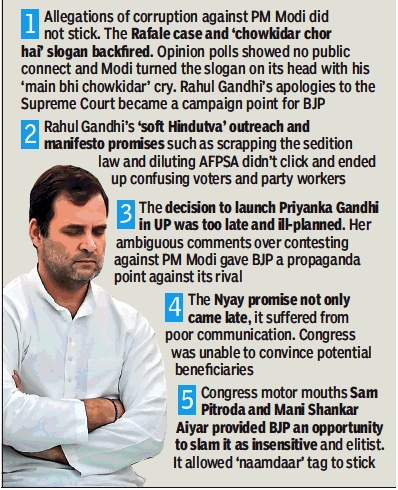
From: May 24, 2019: The Times of India
See graphic :
What didn’t work for Congress
The 17th Lok Sabha: Socio-economic composition
Background check of MPs

From: May 24, 2019: The Times of India
See graphic, 'The background of the MPs of the 17th Lok Sabha: age, assets, education, gender and criminal record '
Age, education, gender
Priyamvada Trivedi, Basim U Nissa and Saloni Bhogale, May 25, 2019: The Times of India

From: Priyamvada Trivedi, Basim U Nissa and Saloni Bhogale, May 25, 2019: The Times of India
See graphic:
MPs of the 17th Lok Sabha: age, education, gender
Religion
In terms of religious composition, 90.4% of the MPs of the new Lok Sabha are Hindus. There are five more Muslims elected than in 2014, which brings Muslims’ representation to 5.2% (from 4.2%). Other religious minorities, such as Sikhs and Christians, represent 4% of the MPs.
Caste
In terms of caste, the composition of the 17th Lok Sabha is practically identical to the 16th. 155 of the 542 elected Parliamentarians, or 28.6%, are upper caste Hindus, the same number as in 2014.
The number of parliamentarians from intermediary castes has reduced from 83 to 77 i.e 14.2% of the parliament.
Party-wise professions: Comparing BJP & INC Winners
Looking at the professions filed by the 303 BJP winners in their self-declared affidavits, we find that most of the winners have declared some form of agriculture as their primary professions, while a smaller share of Indian National Congress’s (INC) elected MPs have declared the same.
These winning candidates come from various backgrounds: spanning professions involving politics (52), business(48) and entertainment(6) and so on.
The winners who report their profession as politics are typically sitting or former MPs or MLAs, which have increased from 38 in 2014 to 61 in 2019.
The BJP has sent an almost equal number of lawyers and entertainers to the newly elected assembly.
We see the likes of actors, film artists, folk singers etc amongst the winning BJP candidates who, on average, have amassed over 55% of the vote share in their respective constituencies.
Gender
There is a marginal increase in the number of women in the 2019 Lok Sabha. The number of women MPs has increased from 11.6% in 2014 to 14.6% in 2019. In absolute terms, the number has increased from 63 to 79.
Correspondingly, the number of male MPs has decreased from about 88.4% in 2014 to 85.4% in 2019.
This pattern of an increase in the number of women MPs in the 2019 Lok Sabha is reflected in the seats won by both the national parties i.e., Bharatiya Janata Party and Indian National Congress.
In absolute terms, the number of women MPs in the BJP has gone up from 30 to 41 (increased from about 10% to 13%). For the INC, this is an increase from 4 to 6 women MPs (9% to 11%).
Incumbents AND THE distribution of terms served
233 of the 542 MPs contested for the first time. 277 are first-time elected, a lower figure than in 2014, when 316 MPs were elected for the first time. The main reason is the good performance of re-running MPs, essentially those contesting on a BJP ticket. 226 re-running MPs have been re-elected, which is a high ratio. 153 of the 169 re-running BJP MPs have been re-elected.
118 MPs are serving for the third time or more. The two Lok Sabha veterans are Maneka Gandhi (Sultanpur) and Santosh Kumar Gangwar (Bareilly), both elected for the eighth time.
(Priyamvada Trivedi is Associate Director of the Trivedi Centre for Political Data, Ashoka University. Basim U Nissa and Saloni Bhogale are Research Fellows at the Trivedi Centre for Political Data, Ashoka University. We are thankful to Sudheendra Hangal, Gilles Verniers, Mohit Kumar, and Sofia Ammassari for data processing and comments)
Extremes
The avocations of MPs
The wealth of parliamentarians
SESSION-WISE PRODUCTIVITY
2019
Budget session
Akhilesh Singh, July 18, 2019: The Times of India
Encouraged by the proceedings in Parliament in the current session which has been the most productive in the last 20 years, the government is contemplating to extend the sittings for a few more days, a day after PM Narendra Modi dropped hints about it while addressing the BJP parliamentary party meet on Tuesday.
Several legislations are still pending and the government is keen on getting most of them cleared by extending the session rather than calling a separate Monsoon session. “After the current session, the next will be the winter session,” a source said.
A senior functionary said, “There is a possibility of the extension of the session. However, formal decision in this regard is likely in a few days.”
As the first session of the 17th Lok Sabha has been working for more than its scheduled time, its productivity has been the highest in the past 20 years. According to data released by PRS, Lok Sabha’s productivity till July 16 is at 128% which is the highest for any session in the past 20 years. Next highest were the Budget session in 2016 and winter session in 2014 clocking almost 125% of productivity. On July 11, the productivity of Lok Sabha was the highest as the House discussed Demand for Grants for ministry of railways till midnight. Sources said Speaker Om Birla had urged the Lok Sabha secretariat to look at the logistical support till early morning as initial plan was to go ahead till 3am.
A productive session
Ambika Pandit, August 7, 2019: The Times of India
Most fruitful LS session in 20 years
As many as 35 bills were passed in the first session of the 17th Lok Sabha, which worked for 281 hours through 37 sittings, which is the highest for any lower House session in the past 20 years, according to an analysis by PRS Legislative Research. It said Lok Sabha members worked for 135% of the scheduled hours, reports Ambika Pandit.
Speaker Om Birla said in his valedictory address that the first session of this Lok Sabha was more productive than the opening session of India’s first LS in 1952, when 24 bills were passed in 67 sittings.
Winter session
116% productivity
The Lok Sabha recorded productivity of 116% in the winter session while for Rajya Sabha it was at 99%, parliamentary affairs minister Pralhad Joshi said on Friday, the last day of the session.
Fourteen bills were passed by the Lower House while 15 bills were passed by Rajya Sabha. Overall, 15 bills were passed by both Houses of Parliament, Joshi said Noting that the historic 250th session of Rajya Sabha was marked by “seriousness and brevity”, chairperson M Venkaiah Naidu complimented the MPs for improving the quality of debates on several issues, ranging from the state of the economy and the Pegasus spyware to the Surrogacy and Citizenship (Amendment) Bill. Naidu said, “While the last session recorded productivity of 104% by availing more than the available time for transacting business, this session too has clocked 100% productivity.”
“This is perhaps for the first time that this house has recorded 100% productivity for two successive sessions…I am glad that all of you have collectively risen to the occasion and kept up the happy tide,” he said, in his valedictory address before adjourning Rajya Sabha sine die.
Addressing a press conference after both Houses were adjourned sine die, Joshi said that this is perhaps for the first time when Lok Sabha Speaker Om Birla was interrupted by Congress members when he was making concluding remarks about the session.
As against the total scheduled time of 108 hours and 33 minutes during this session with 20 sittings, Rajya Sabha functioned for 107 hours and 11 minutes, resulting in a productivity of 99%. A total of 11 hours and 47 minutes, accounting for about 11% of the available time, was lost due to interruptions. “But spurred by the sense of duty, the members sat for 10 hours and 52 minutes beyond the scheduled hours, resulting in productivity of close to 100% during this session,” said Naidu.
The Transgender Persons (Protection of Rights) Bill, the Citizen (Amendment) Bill, The Constitution (126th Amendment) Bill extending reservations for SCs and STs in legislatures by another 10 years, the ban on e-cigarettes and the International Financial Services Centre Bill were among the 15 legislations passed by the Upper House during the session.
“I am particularly happy over all of you collectively demonstrating that parliamentary democracy is more about contestation of ideas and ideologies than confrontation, which carries a tinge of conflict in its womb. The quality of debates on several occasions bear this out,” the RS chairman added.
2021
Monsoon
Hours lost in August
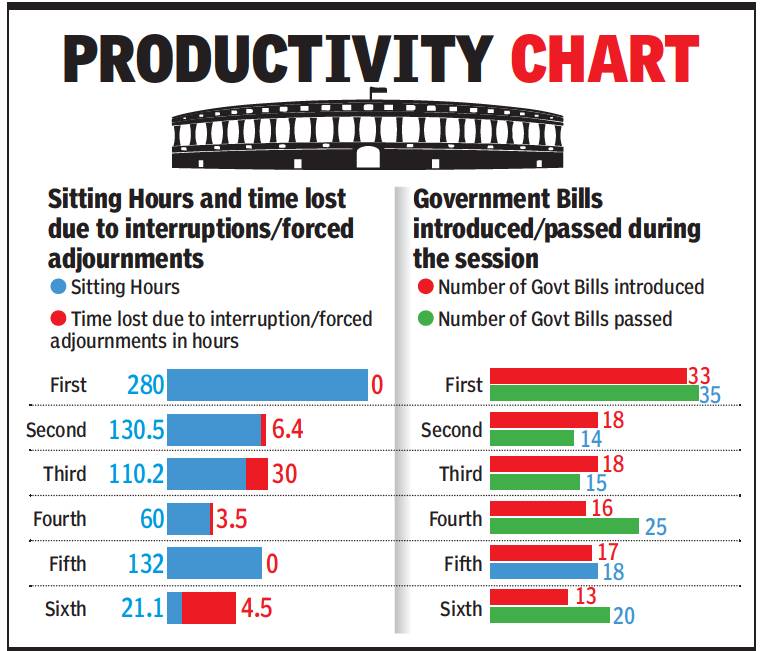
From: August 12, 2021: The Times of India
See graphic:
Hours lost in August 2021 in Parliament
See also
Parliament: India (general issues): Issues that pertain to both the Rajya Sabha and the Lok Sabha.
The 15th Lok Sabha: 2009-14: Productivity
The 16th Lok Sabha (2014-19): MPs : A complete list of the MPs elected in 2014.
The 16th Lok Sabha (2014-19): trends
The 17th Lok Sabha (2019- 24): trends : Trends in the Lok Sabha Elections.
The 17th Lok Sabha (2019-24): MPs: A complete list of the MPs elected in 2019.
The 17th Lok Sabha: 2019-24: Productivity and work done session by session Productivity, and work done session by session
The 18th Lok Sabha (2024- ): MPs: A complete list of the MPs elected in 2024.
The 18th Lok Sabha (2024- ): trends: Trends in the Lok Sabha Elections.
The 18th Lok Sabha: 2024- : Productivity and work done session by session
See also
Parliament: India (general issues): Issues that pertain to both the Rajya Sabha and the Lok Sabha.
The 15th Lok Sabha: 2009-14: Productivity
The 16th Lok Sabha (2014-19): MPs : A complete list of the MPs elected in 2014.
The 16th Lok Sabha (2014-19): trends
The 17th Lok Sabha (2019- 24): trends : Trends in the Lok Sabha Elections.
The 17th Lok Sabha (2019-24): MPs: A complete list of the MPs elected in 2019.
The 17th Lok Sabha: 2019-24: Productivity and work done session by session Productivity, and work done session by session
The 18th Lok Sabha (2024- ): MPs: A complete list of the MPs elected in 2024.
The 18th Lok Sabha (2024- ): trends: Trends in the Lok Sabha Elections.
The 18th Lok Sabha: 2024- : Productivity and work done session by session